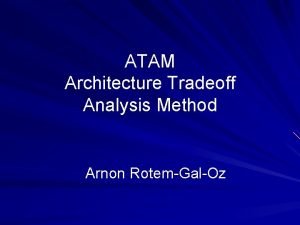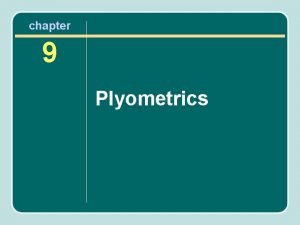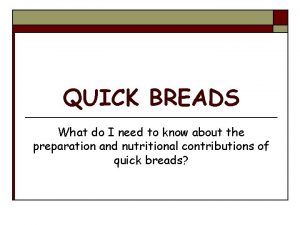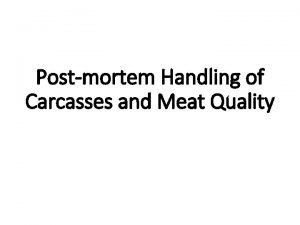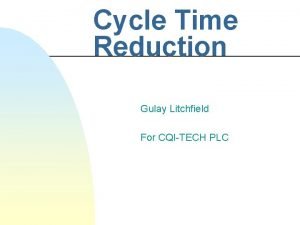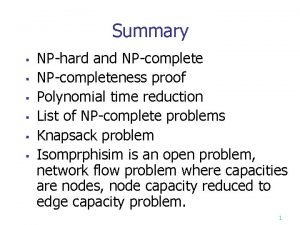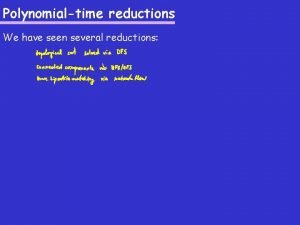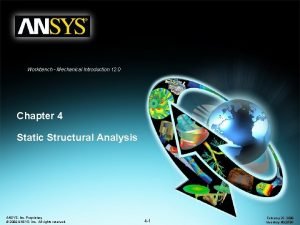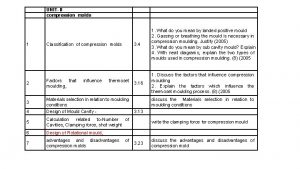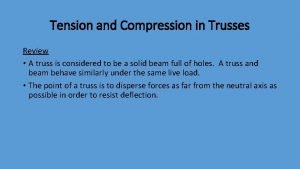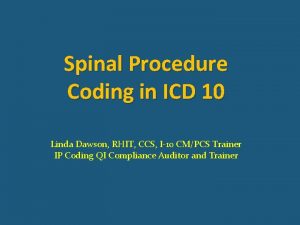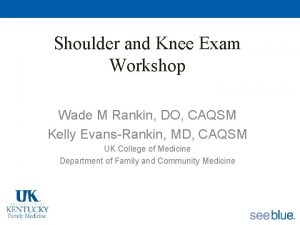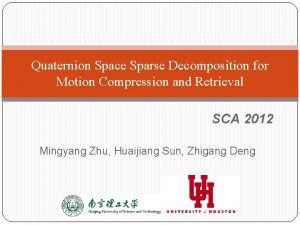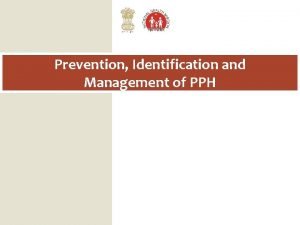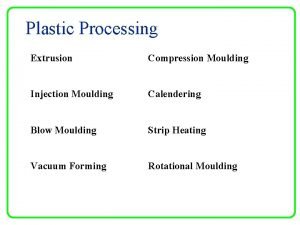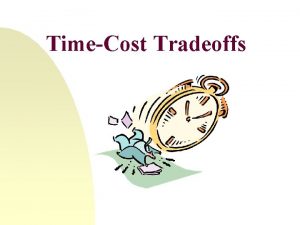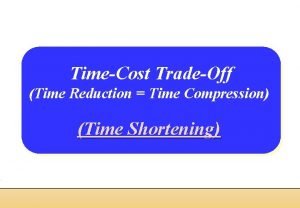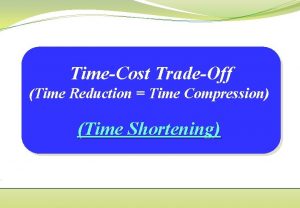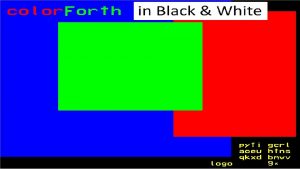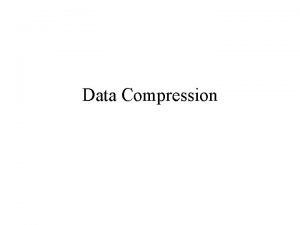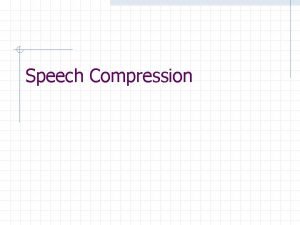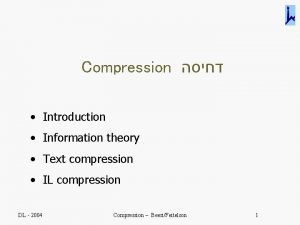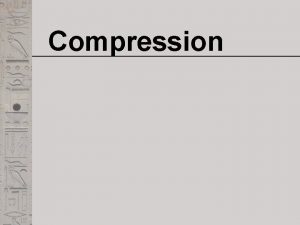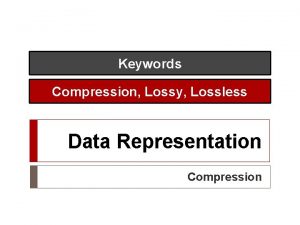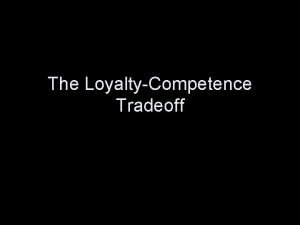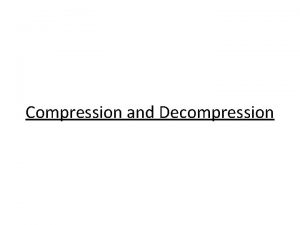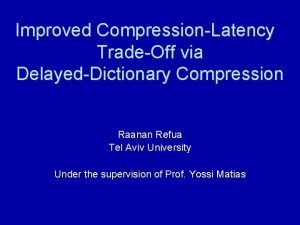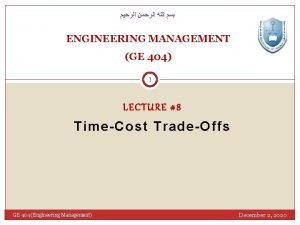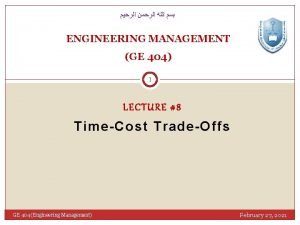TimeCost TradeOff Time Reduction Time Compression Time Shortening


































- Slides: 34

Time-Cost Trade-Off (Time Reduction = Time Compression) (Time Shortening)

Reasons to Reduce Project Durations: ØTo avoid late penalties (or avoid damaging the company’s relationship), ØTo realize incentive pay, (monetary incentives for timely or early competition of a project, ØTo beat the competition to the market, to fit within the contractually required time (influences Bid price) ØTo free resources for use on other projects. (complete a project early & move on to another project) ØTo reduce the indirect costs associated with running the project. ØTo complete a project when weather conditions make it less expensive (Avoid temporary Heating, avoid completing site work during raining season). ØMany things make crashing a way of life on some projects (i. e. last minutes changes in client specification, without permission to extend the project deadline by an appropriate increment) Shortening the duration is called project crashing

Methods to reduce durations 1. Overtime: Have the existing crew work overtime. This increase the labor costs due to increase pay rate and decrease productivity. 2. Hiring and/or Subcontracting: a) Bring in additional workers to enlarge crew size. This increases labor costs due to overcrowding and poor learning curve. b) Add subcontracted labor to the activity. This almost always increases the cost of an activity unless the subcontracted labor is for more efficient. 3. Use of advanced technology: Use better/more advanced equipment. This will usually increase costs due to rental and transport fees. If labor costs (per unit) are reduced, this could reduce costs.

How project cost is estimated? Practices to Estimate the Project cost Ø Some company assigns Overhead office as % of direct cost. Ø Most companies don’t consider profit as a cost of the job. Ø Cost analysis are completed by using: o [Direct costs + Indirect costs + Company overhead] vs. Budgeted (estimated costs). Ø Similar to each activity, the project as a whole has an ideal (Lease expensive) Duration.

How project cost is estimated?

How project is crashed? Specify 2 activity times and 2 costs o 1 st time/cost combination (D, CD)- called normal [Normal – usual ‘average’ time, resources] o 2 nd time/cost combination (d, Cd)- called Crash [expedite by applying additional resources]

Steps in Project Crashing Basic Steps 1. Compute the crash cost per time period. If crash costs are linear over time: 2. Using current activity times, find the critical path and identify the critical activities

Steps in Project Crashing 3. If there is only one critical path, then select the activity on this critical path that (a) can still be crashed, and (b) has the smallest crash cost period. If there is more than one critical path, then select one activity from each critical path such that (a) each selected activity can still be crashed, and (b) the total crash cost of all selected activities is the smallest. Note that the same activity may be common to more than one critical path. 4. Update all activity times. If the desired due date has been reached, stop. If not, return to Step 2.

Example 1: Crashing The Project Critical Path for Milwaukee Paper (A, C, E, G, H) 0 2 2 4 4 3 7 C F 2 0 4 10 6 13 A 0 0 2 0 4 4 8 Start 0 0 13 2 15 H E 0 13 0 15 4 0 8 0 3 3 B 1 1 4 3 4 7 8 5 13 D G 4 1 8 8 0 13

Example 1: Crashing The Project CALCULATION OF CRAH COST/PERIOD Crash and Normal Times and Costs for Activity B Activity Cost Crash $34, 000 — $33, 000 — Crash Cost, Cd = $32, 000 — = $31, 000 — $30, 000 — Normal Cost, CD Crash Cost – Normal Cost Normal Time – Crash Time Crash Cost/Wk = $34, 000 – $30, 000 3– 1 $4, 000 = $2, 000/Wk 2 Wks Normal — | 1 Crash Time, d | 2 | 3 Normal Time, D Table 3. 16 (Frome Heizer/Render; Operation Management) Time (Weeks)

Example 1: Crashing The Project Time (Wks) Activity Normal A B C D E F G H 2 3 2 4 4 3 5 2 Crash 1 1 1 2 2 1 Cost ($) Normal 22, 000 30, 000 26, 000 48, 000 56, 000 30, 000 80, 000 16, 000 Table 3. 5 (Frome Heizer/Render; Operation Management) Crash 22, 750 34, 000 27, 000 49, 000 58, 000 30, 500 84, 500 19, 000 Crash Cost Critical Per Wk ($) Path? 750 2, 000 1, 000 500 1, 500 3, 000 Yes No Yes

Example 2: Crashing Project (123) For the small project shown in the table, it is required reduce the project duration. A) Reduce by 2 periods. B) Reduce by 5 periods. Activity Precedence Normal Crash Time, day Cost, $ A - 4 210 3 280 B - 8 400 6 560 C A 6 500 4 600 D A 9 540 7 600 E B, C 4 500 1 1100 F C 5 150 4 240 G E 3 150 H D, F 7 600 6 750 Σ 3050 4280

Example 2: Crashing Project (123) 1 - develop network Activity Precedence A Normal Crash Time, day Cost, $ - 4 210 3 280 B - 8 400 6 560 C A 6 500 4 600 D A 9 540 7 600 E B, C 4 500 1 1100 F C 5 150 4 240 G E 3 150 H D, F 7 600 6 750 Σ 3050 4280 9 D 4 6 5 7 A C F H FINISH START 8 4 3 B E G

Example 2: Crashing Project (123) 2 - calculate times, find critical path 9 4 13 D 6 0 4 4 4 A 0 0 0 START 0 0 0 6 2 15 10 4 0 15 F C 4 15 10 10 0 7 22 H 15 15 0 22 22 0 22 FINISH 0 8 8 10 B 7 7 4 14 14 Ø Project completion time = 22 working days Ø Critical Path: A, C, F, H. 15 5 17 22 0 22 G E 15 3 19 Activity Total float Free float 19 A 0 0 5 22 B C D 7 0 2 2 0 2 E F G H 5 0 0 0 5 0

Example 2: Crashing Project (123) 3 - calculate cost slope Activity Precedence Time, day Cost, $ Cost Slope, $/day Normal Crash A - 4 210 3 280 70 B - 8 400 6 560 80 C A 6 500 4 600 50 D A 9 540 7 600 30 E B, C 4 500 1 1100 200 F C 5 150 4 240 90 G E 3 150 ** H D, F 7 600 6 750 150 Σ 3050 4280 Remarks 1 - [G can not expedite] 2 - lowest slope and can be expedited on critical path is activity (C) WITH 2 periods

Example 2: Crashing Project (123) Reduce 2 periods of activity (C) with increase of cost (2*50) =100 ES Activity Precedence A LS Activity EF TF LF Crash limit (d @ cost) 9 4 13 D 4 0 4 4 4 A 0 0 0 START 0 0 0 4 0 8 4 0 Cost Slope, Time, day Cost, $ $/day - 4 210 3 280 70 B - 8 400 6 560 80 C A 6 500 4 600 50 D A 9 540 7 600 30 E B, C 4 500 1 1100 200 F C 5 150 4 240 90 G E 3 150 ** H D, F 7 600 6 750 150 Σ 8 5 13 13 F 8 Crash 3050 4280 13 C 4 Normal 8 0 7 20 H 13 13 0 20 20 FINISH 0 8 8 8 B 5 5 4 12 12 13 5 15 20 0 20 G E 13 3 17 Ø Project completion time = 20 working days Activity Total float Ø Critical Path: A, C, F, H. & A, D, H Free float 17 5 20 A 0 0 B C D 5 0 0 0 E F G H 5 0 0 0 5 0

Example 2: Crashing Project (123) Reduce 1 period of activity (A) with increase of cost =70 9 3 Activity Precedence A 12 D 3 0 3 3 3 A 0 0 0 START 0 0 0 4 0 7 3 0 Cost Slope, Time, day Cost, $ $/day - 4 210 3 280 70 B - 8 400 6 560 80 C A 6 500 4 600 50 D A 9 540 7 600 30 E B, C 4 500 1 1100 200 F C 5 150 4 240 90 G E 3 150 ** H D, F 7 600 6 750 150 Σ 7 5 12 12 F 7 Crash 3050 4280 12 C 3 Normal 7 0 7 19 H 12 12 0 19 19 0 19 FINISH 0 8 8 7 B 8 4 4 11 11 12 5 14 19 0 19 G E 12 3 16 Ø Project completion time = 19 working days Activity Total float Ø Critical Path: A, C, F, H. & A, D, H Free float 16 5 19 A 0 0 B C D 4 0 0 0 E F G H 5 0 0 0 5 0

Example 2: Crashing Project (123) Activity Precedence A Reduce farther 1 period of 2 activities (D, F) with increase of cost (30+90) =120 3 8 11 D 3 0 3 3 3 A 0 0 0 START 0 0 0 4 0 3 0 Crash Cost Slope, Time, day Cost, $ $/day - 4 210 3 280 70 B - 8 400 6 560 80 C A 6 500 4 600 50 D A 9 540 7 600 30 E B, C 4 500 1 1100 200 F C 5 150 4 240 90 G E 3 150 ** H D, F 7 600 6 750 150 Σ 3050 4280 11 7 7 4 11 11 F C 3 Normal 7 7 0 7 18 H 11 11 0 18 18 0 18 FINISH 0 8 8 7 B 3 3 4 11 11 11 Ø Project completion time = 19 working days Ø Critical Path: A, C, F, H. & A, D, H 14 15 15 4 Activity Total float Free float A 0 0 B C D 3 0 0 0 4 18 0 18 G E 11 3 18 E F G H 4 0 0 0 4 0

Example 2: Crashing Project (123) Activity Precedence A Reduce farther 1 period of activity (H) with increase of cost =150 3 8 11 D 3 0 3 3 3 A 0 0 0 START 0 0 0 4 0 3 0 Crash Cost Slope, Time, day Cost, $ $/day - 4 210 3 280 70 B - 8 400 6 560 80 C A 6 500 4 600 50 D A 9 540 7 600 30 E B, C 4 500 1 1100 200 F C 5 150 4 240 90 G E 3 150 ** H D, F 7 600 6 750 150 Σ 3050 4280 11 7 7 4 11 11 F C 3 Normal 7 7 0 6 17 H 11 11 0 17 17 0 17 FINISH 0 8 8 7 B 2 2 4 11 11 10 Ø Project completion time = 19 working days Ø Critical Path: A, C, F, H. & A, D, H 14 14 14 3 Activity Total float Free float A 0 0 B C D 2 0 0 0 3 17 0 17 G E 10 3 17 E F G H 3 0 0 0 3 0

Example 2: Crashing Project (123) Reduction from 22 to 17 increase to 3490 Cycle Activity Time cost Total cost 22 100 3150 20 1 70 3220 19 D, F 1 30+90 3340 18 H 1 150 3490 17 - 1 C 2 2 A 3 4 Precedence A Duration 3050 0 Activity Normal Crash Time, day Cost, $ $/day - 4 210 3 280 70 B - 8 400 6 560 80 C A 6 500 4 600 50 D A 9 540 7 600 30 E B, C 4 500 1 1100 200 F C 5 150 4 240 90 G E 3 150 ** H D, F 7 600 6 750 150 Σ 3050 3550 3450 Cost 3350 3250 3150 3050 2950 16 17 18 19 20 Project Duration Cost Slope, 21 22 23 4280

Example 2: Crashing Project (123) Accelerating the Critical and Noncritical path Normal Activity Precedence Crash Cost Slope, Time, day Cost, $ $/day A - 4 210 3 280 70 B - 8 400 6 560 80 C A 6 500 4 600 50 D A 9 540 7 600 30 E B, C 4 500 1 1100 200 F C 5 150 4 240 90 G E 3 150 ** H D, F 7 600 6 750 150 Σ 3050 4280

How project is crashed? Network Compression Algorithm Ø Determine Normal project duration, and cost. Ø Identify Normal duration Critical Path. Ø For large network, using CRITICALITY THEORM to eliminate the noncritical paths that do not need to be crashed. Ø Compute the cost slop

How project is crashed? Network Compression Algorithm Ø shortening the CRITICAL ACTIVITIES beginning with the activity having the lowest cost-slope Ø Determine the compression limit (Nil) Ø Organize the data as in the following table:

How project is crashed? Network Compression Algorithm Ø Update the project network Ø When a new Critical path is formed: - Shorten the combination of activity which Falls on Both Critical Paths, OR - Shorten one activity from each of the critical paths. Use the combined cost of shortening both activities when determining if it is cost effective to shorten the project. Ø At each shortening cycle, compute the new project duration and project cost Ø Continue until no further shortening is possible

How project is crashed? Network Compression Algorithm Ø Tabulate and Plot the Indirect project Cost on the same timecost graph Ø Add direct and indirect cost to find the project cost at each duration. Ø Use the total project cost-time curve to find the optimum time.

Example 3 38470

Example 3

Example 3

Example 3

Example 3

Example 3

Example 3

Example 3 Project Optimal Duration

CASE WORK
 Bias variance tradeoff
Bias variance tradeoff Atam example
Atam example The key tradeoff featured in the compromise of 1877
The key tradeoff featured in the compromise of 1877 Narath vascular sign
Narath vascular sign Stretch shortening cycle phases
Stretch shortening cycle phases Blends and acronyms
Blends and acronyms What are the nutritional contributions of yeast breads
What are the nutritional contributions of yeast breads Cold shortening and thaw rigor
Cold shortening and thaw rigor Distance decay vs time space compression
Distance decay vs time space compression Model ap human geography
Model ap human geography Time space compression ap human geography
Time space compression ap human geography Time space compression ap human geography
Time space compression ap human geography Prepositional phrase as adverb
Prepositional phrase as adverb Cycle time reduction techniques
Cycle time reduction techniques Polynomial time reduction
Polynomial time reduction Polynomial time reduction examples
Polynomial time reduction examples Compression only support ansys
Compression only support ansys Whats a transverse wave
Whats a transverse wave Pot type & plunger type are the classification of
Pot type & plunger type are the classification of Transformations of linear functions
Transformations of linear functions Compression and rarefaction
Compression and rarefaction Tibiofemoral joint
Tibiofemoral joint Truss tension compression
Truss tension compression Durotomy repair icd 10 pcs
Durotomy repair icd 10 pcs Hyporeflexia and hyperreflexia
Hyporeflexia and hyperreflexia Rotator cuff tests
Rotator cuff tests Quaternion compression
Quaternion compression Bimanual compression
Bimanual compression Uterine atony causes
Uterine atony causes Uterine atony
Uterine atony Calendering moulding
Calendering moulding Basic life support
Basic life support Reduce storage oracle
Reduce storage oracle What is data compression in multimedia
What is data compression in multimedia Spatial redundancy in video compression
Spatial redundancy in video compression

